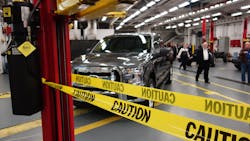DEARBORN, MI. Ford has a lot riding on the success of its next generation F150 pickup. Routinely grabbing best-selling vehicle honors, the F150 is a storied and extremely successful brand, and even minor changes are big news to its many fans. But with the all-new 2015 truck, Ford has chosen to forego caution, introducing major innovations that include an all-aluminum body and a completely new 2.7-liter V6 engine.
So even though the new F150 doesn't go on sale until the Fall, the company is orchestrating a series of events highlighting elements of its development that will build to a crescendo with its official launch in October. The first of those events, held at the Ford Research and Innovation Center on its Dearborn campus, focused on the enormous amount of durability testing that goes into creating a new work truck that will have to be tough enough to live up to big expectations.
Without a doubt, the biggest change for the 2015 F150 is a cab and bed made from high-strength aluminum alloy, a first for a pickup, according to the project chief engineer Pete Reyes. The advanced aluminum materials account for 70% of the new F150's 700 lbs. weight reduction, while also avoiding rust that can plague work trucks subject to scrapes and harsh environments.
While it's a first for a pickup, aluminum bodies are not new to Ford, which did much of the development work on the aluminum body for the Jaguar XJ8, according to Ford manufacturing research manager Peter Friedman. What many might not know is that aluminum is only one-third the density of steel, allowing Ford to actually increase the thickness of the new F150's body panels for greater durability, he said during a tour of the research center.
Friedman then pointed to a foot-long scrape on a test truck's fender placed there intentionally by engineers over two years ago. Even though the truck is stored outside, it showed no corrosion.
Durability testing for the new cab and bed was conducted both in the Ford labs and on the road, as the company rolled up 10 million test miles, according to Raj Nair, group VP for global product development. By comparison, the current F150, which was introduced in 2009, saw two million miles of testing, he said.
Cab testing at the Ford Proving Grounds included twisting the entire cab and frame structure with hydraulic rams to simulate heavy loads on rough roads over 225,000-mi. cycles. Those tests resulted in no cab durability failures, a first for the Ford labs, according to Mark Keller, manager of structures and body.
Ford also field tested the new material by mounting aluminum beds on current model F150s and putting them into routine duty with fleets in oil-field service, heavy construction and other harsh applications for over 2 years and 300,000 mi. Those tests resulted in some design changes rolled into the coming truck, Keller said.
While the new F150 retains high-strength steel for its fully boxed frame rails, engineers managed to cut weight by 60 lbs. while increasing strength and crash attributes, according to Ford manager of chassis engineering John Caris. Among the material innovations for the new frame is use of a steel rolling technology that results in various thicknesses in a single plate.
Even seemingly small issues were subject to durability testing. On display during the Dearborn press event were examples of steel and aluminum fasteners used to test anti-corrosion properties, the results of testing paints and interior materials for solar fading, and even a machine that replicated finger pressure to test the durability of inks and paints used on switches and interior trims.
Ford isn't ready to release hard performance and power numbers for the F150's all-new EcoBoost 2.7-liter engine, but it was happy to share some of its design highlights and durability testing routines.
The new V6 is a compact package weighing only about 370 lbs. It features a compacted graphite iron (CGI) block, polymer-coated bearings, direct fuel injection, twin turbochargers, variable cam timing and even a variable displacement oil pump that responds to engine loads. The new engine was also designed from the ground up for a smart automatic start/stop system that automatically disengages when it detects towing or four-wheel drive.
Durability testing included running engines on dynamometers continuously for 350 hrs. at peak speeds and loads, then tearing them down to examine component wear. Thermo-cycle testing chilled engines down to -20F, started and held them at peak power for seven minutes, then shocked them with -20F coolant in a cycle that was repeated 350 times to evaluate gaskets and seals. Finally all the engine's systems were run through transient driving cycles on the dynamometers designed to replicate urban stop-and-go traffic, towing and other real-world conditions.
Ford chose to start their slow build up to the new F150's introduction with a look at the hard-core engineering behind the redesign. While they aren't showing their hand yet, expect similar events in the near future to focus on the new pickup's safety, fuel efficiency and performance. And then, finally, the truck itself.
About the Author
Jim Mele
Jim Mele is a former longtime editor-in-chief of FleetOwner. He joined the magazine in 1986 and served as chief editor from 1999 to 2017.
